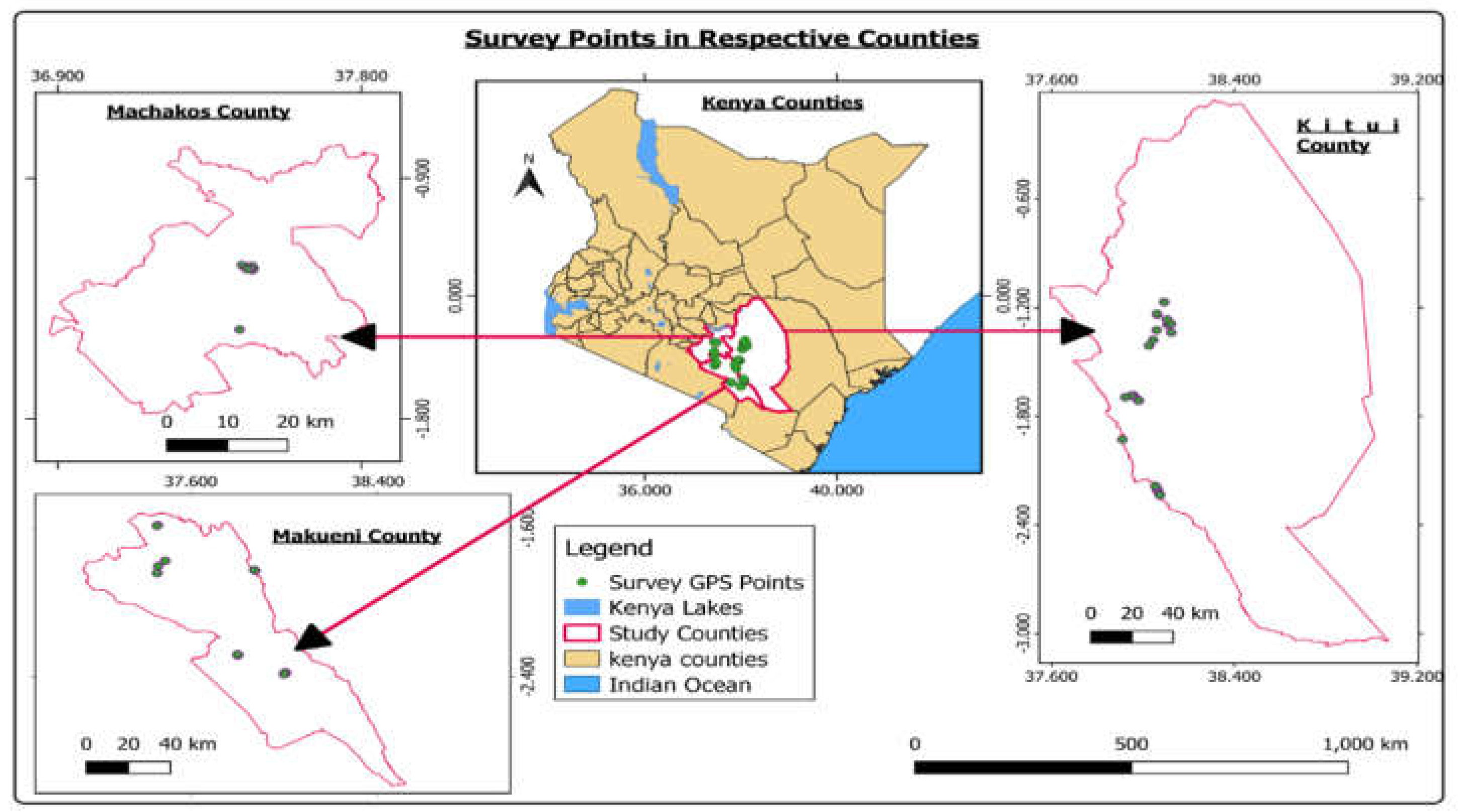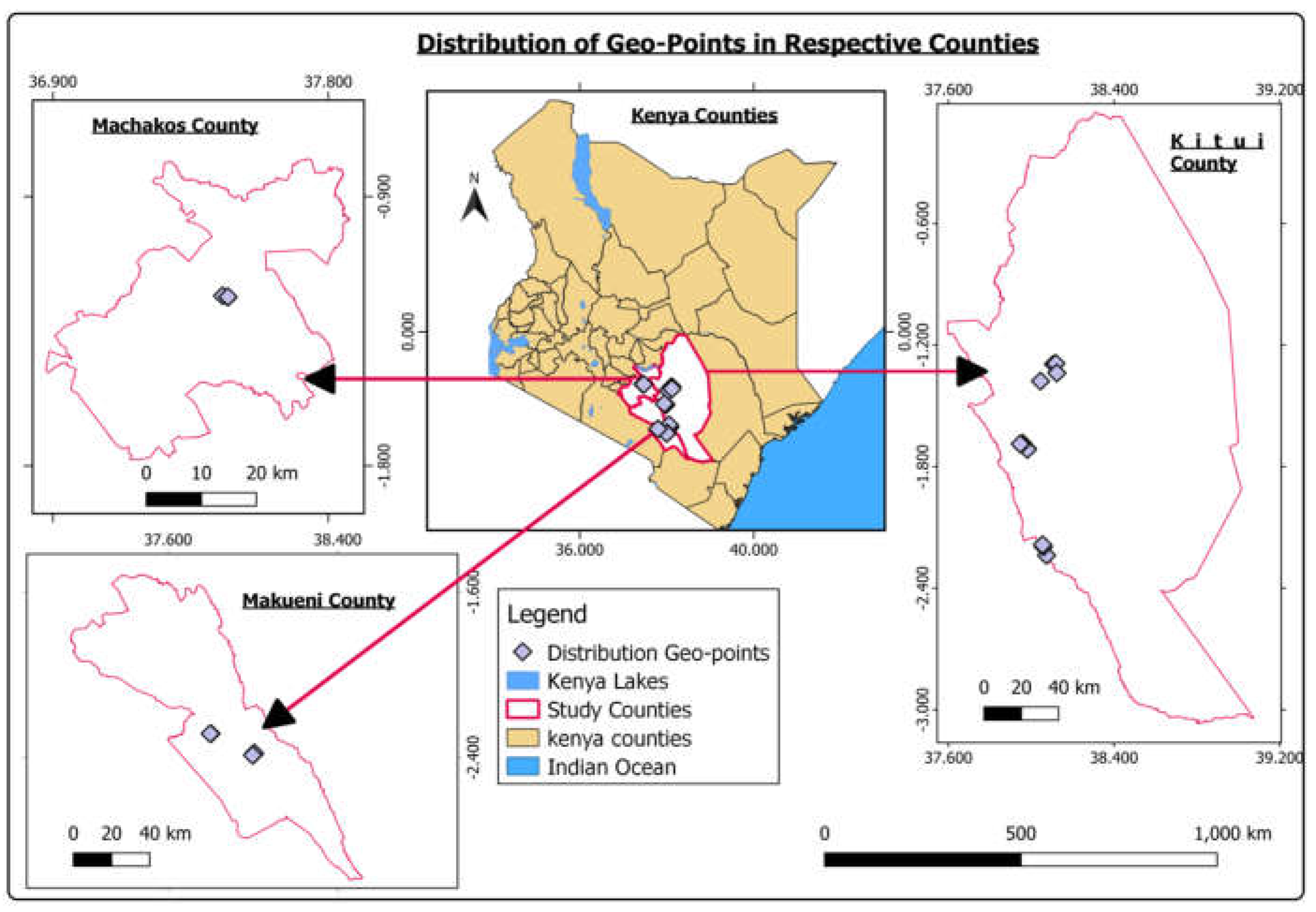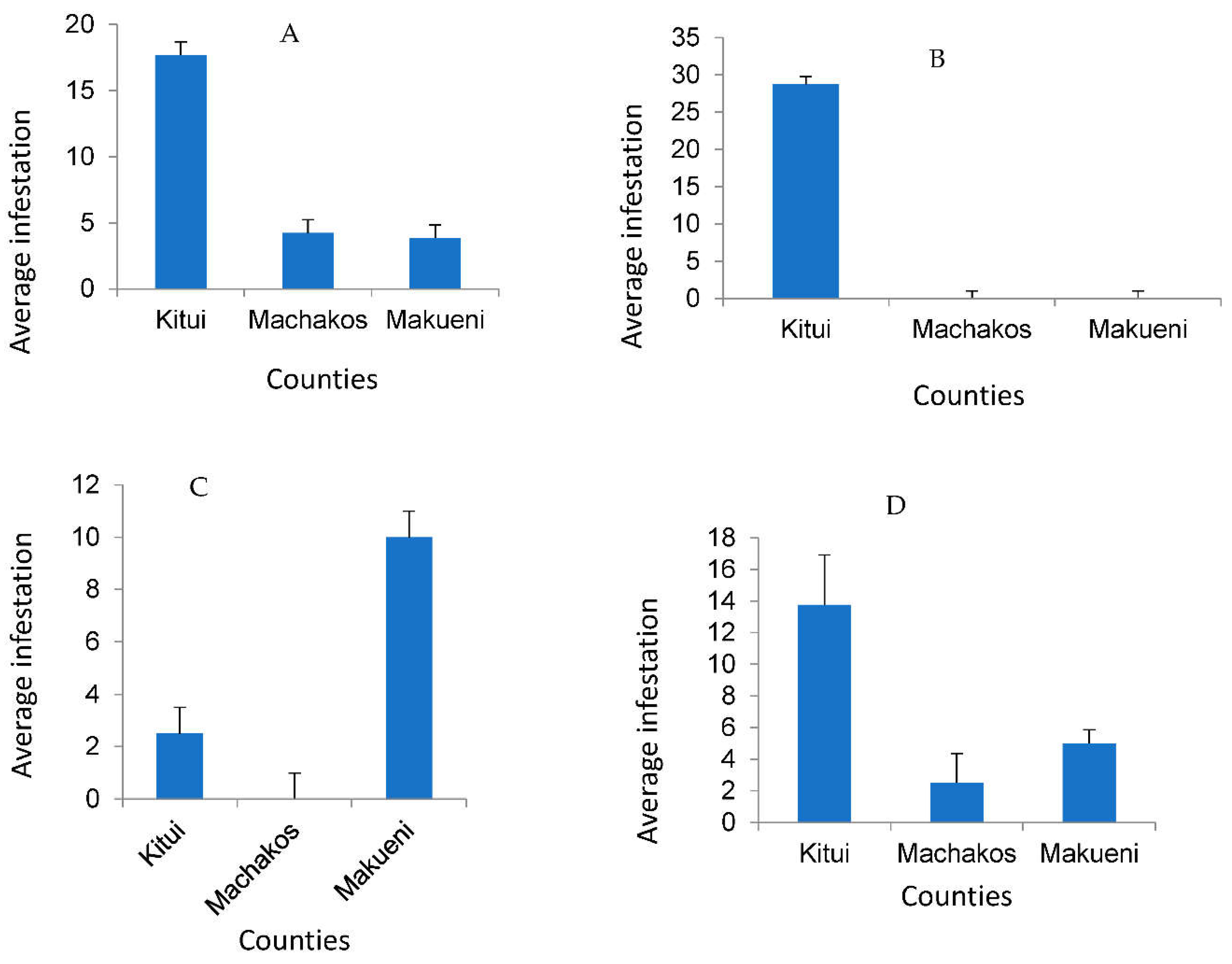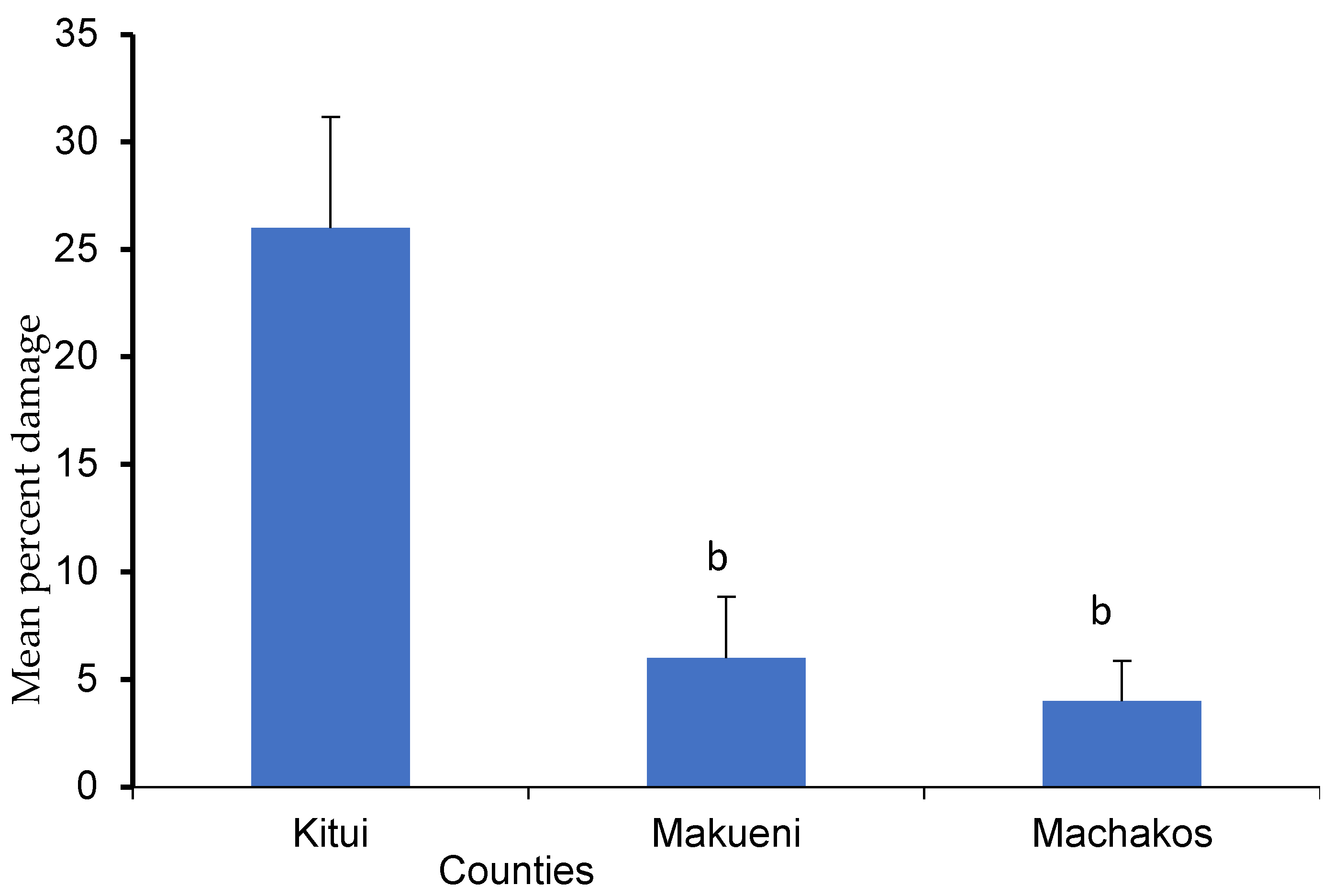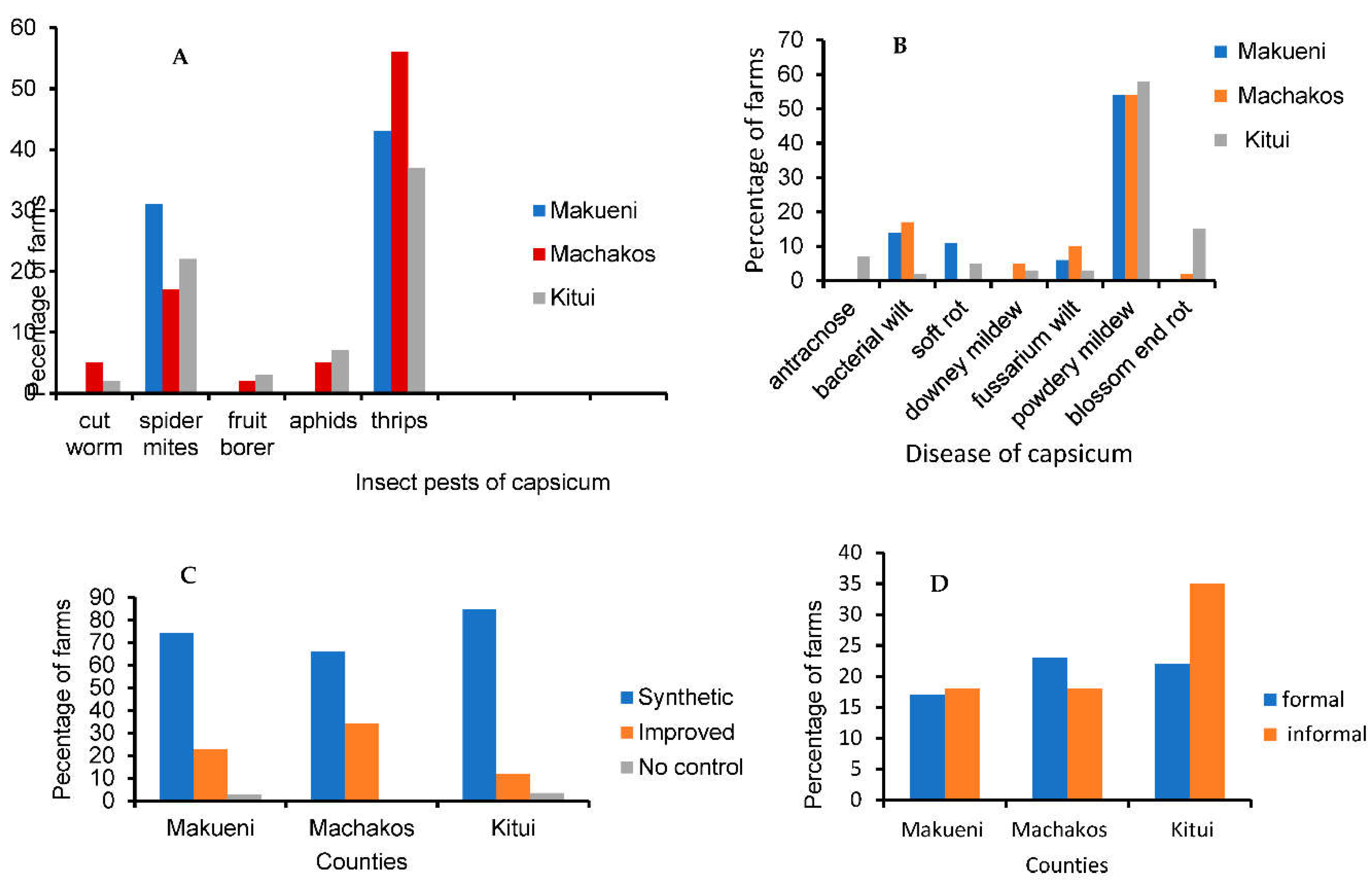1. Introduction
The false codling moth (FCM),
Thaumatotibia leucotreta (Meyrick) (Lepidoptera: Tortricidae) is one of the economically important lepidopteran insect pests, that is believed to originate from sub-Saharan Africa [
1,
2,
3]. The pest is polyphagous and attacks more than 70 host plants including avocado (
Persea america) Citrus (
citrus spp.), corn (
Zea may), mangoes (
Mangifera indica), cotton (
Gossypium herbaceum), macadamia (
Macadamia integrifolia), and capsicum (
Capsicum spp.) [
2,
4]. Feeding and development of larvae on the pod, bolls, seeds, and cobs of the host plant affect its growth resulting in premature fruit drop [
3,
5]. Damage to the fruit makes it more vulnerable to scavengers and reduces the quality of the fruit [
6].
Thaumatotibia leucotreta also causes indirect losses through quarantine restrictions imposed by importing countries, hence reducing the profit margin for millions of farmers and value chain actors in sub-Saharan Africa. The interception of even a single larva in exported fruit or vegetables may result in the rejection of the entire shipment, underscoring the economic importance of this pest in the horticultural industry [
4,
7,
8].
Capsicum well known as pepper is ranked as the third most important vegetable in the world after potatoes and tomatoes [
9]. The crop is believed to originate from Mexico and Central America [
10,
11]. In Kenya, capsicum is widely cultivated and consumed as a vegetable and spice [
12]. According to the 2019 statistics, the total world production of capsicum was approximately 61 million tonnes, covering a cultivated area of about 4.5 million hectares [
13]. Approximately 9300 tones are produced annually in Kenya from estimated acreage of 990 ha [
14]. It is a high-value crop and its fruits are highly nutritious and is produced for both the domestic and export market. However, its production is constrained by insect pests and diseases, with the false codling moth
T. leucotreta being one of the major threats. According to Adom
et al., [
3], an infestation of
capsicum spp. by
T. leucotreta within 5 months resulted in a 90% yield loss. This impoverishes the country due to lost income and food, as well as high production costs as a result of control measures [
15]. For example, the detection of
T. leucotreta in Kenya caused a ban on chilies exported to the United Kingdom and EU, resulting in an economic loss of up to US
$ 9 billion [
16]. These quarantine restrictions also resulted in job losses along the value chain, especially in East Africa where millions of people are involved in capsicum production [
17]. Furthermore, the direct feeding damage by
T. leucotreta serves as an entry point for pathogens such as fungi and bacteria. These lower the quality of the infested produce thereby affecting postharvest fruit market value. This is because aesthetic value is the primary criterion that is applied in determining the quality of fruit produce in the market [
8,
18,
15].
Understanding the occurrence, damage spatial, and temporal distribution of
T. leucotreta is crucial for providing relevant information for the development of appropriate management strategies. A study by [
19] described the population abundance of
T. leucotreta in citrus farms in Kenya and Tanzania and revealed that the population abundance is higher between July and August. Although the occurrence and damage of
T. leucotreta have been reported on citrus, okra, sweet pepper, African eggplant, and chili pepper under field and laboratory conditions [
19], the infestation levels of this pest on these crops, except citrus are still unknown. In addition, farmers’ perception of the pest infestation and factors that influence the population abundance of
T. leucotreta on capsicum has not been determined. Such information is vital in decision-making, particularly in defining pest prevalence. Therefore, the objectives of this study were (i) to assess the abundance and damage levels of
T. leucotreta on capsicum in the selected counties in Lower Eastern Kenya; (ii) to determine farmers' perceptions of the infestation of
T. leucotreta on capsicum
2. Materials and Methods
2.1. Study site
This study was conducted in eastern Kenya in the counties of Kitui (1° 22' 30.2916'' S, 37° 59' 42.7668'' E, 400 m to 766 m above sea level (a.s.l)), Makueni (1°35’-3 °00’ S, and 37°10’-38°30’ E, 995 m a.s.l) and Machakos (1° 31' 3.6624'' S and 37° 15' 48.294'' E, 1,349 m a.s.l) (
Figure 1) between November and December 2021. The three counties are classified as semi-arid, with average annual rainfall ranging between 600 to 1150 mm and average minimum and maximum temperatures ranging between 25 to 30 ºC annually. The rainfall pattern is bimodal, with short rain falling between October and December and long rains between March and April [20-22]. Most farmers in the three counties practice mixed farming with major crops being fruit trees (mainly mango), mixed with cowpeas, sorghum, mung beans, beans, pigeon peas, and maize. Horticultural crops such as capsicum, onions, and tomatoes are grown under both rainfed and irrigation conditions. Farm size under capsicum production ranges between 0.1 to 3 acres. The main varieties of capsicum grown are Califonia Wonder and Supper bell. However, other varieties such as bullet, long chilies, and demon are also grown in the three counties.
2.2. Sampling procedure
A stratified random sampling approach was adopted in this study. Counties represented strata while farms were selected randomly based on the availability of the crop at the time of the survey. A total of 75 farms (28 Kitui, 24 Machakos, and 23 Makueni counties) were selected and visited in the three counties during the survey period. Capsicum farms were examined diagonally at random to assess the occurrence and damage of T. leucotreta. The occurrence was determined through the presence of the pest symptoms including entry holes, the presence of frass, chewed skin, scars, the presence of eggs, discoloration, and the presence of T. leucotreta caterpillars on/in the fruit and pupae in the soil. We sampled 10% of every 200 plants on each farm. A total of 50 fruits were collected from each farm and placed in khaki mafuco bags (Paperbags Limited, Nairobi Kenya), labeled, and transported to the Animal Rearing and Quarantine Unit at the International Centre of Insect Physiology and Ecology (icipe) for rearing. The size of the farm, GPS coordinates, and other crops grown on the farm were recorded. To understand farmers’ knowledge, perceptions, and management practices against T. leucotreta in capsicum production areas qualitative information was obtained during the sampling using administered well-structured questionnaires. Each farmer was face–to–face interviewed to collect information on respondent characteristics (e.g age, education, and occupation), household characteristics (e.g household income, farm size), cropping systems, source of seeds, farmers’ knowledge of T. leucotreta and other pests, and management practices.
2.3. Factors influencing the population of T. leucotreta
Climatic factors including temperature, relative humidity, and precipitation data were obtained from the online National Aeronautics and Space and Administration Prediction of Worldwide Energy Resource (NASA POWER)). This is provided on a global grid with a resolution of 0.5◦ latitude by 0.5◦ longitude, the NASA POWER’s website ((
http://power.larc.nasa.gov/, accessed on 4th February 2022). The provided data for these climatic parameters were recorded for the period between November and December. The specific point of analysis entered in the POWER interface was within surveyed areas in the selected counties, with the decimal degrees coordinates (latitude and longitude) converted to corresponding to degrees, minutes, and seconds format in the. Using Excel average of each variable per farm was obtained. These data were used to understand whether the population abundance of
T. leucotreta in capsicum farms is affected by climatic factors. In addition, elevation and the cropping system (monocrop and intercrop) in each farm were determined and then used to assess their influence on the population abundance of
T. leucotreta.
2.4. Sample processing
Each fruit was accessed for
T. leucotreta damage symptoms, weighed, placed in perforated plastic lunch boxes with sand provided as pupation media, and incubated for three weeks. The incubated fruits were dissected and the
T. leucotreta larvae were counted. The fruits were checked daily until the final larval instar popped out to pupate in the soil. The pupae were monitored until the moths emerged. The moths were also counted. The moths were placed in cages for multiplication of the colony, at 25.0 ± 2.0 °C, 60% RH, and 12:12 L: D. Preparation of artificial diet and rearing were done following procedures described by [
23] and [
19]. The percentage of fruit infested with
T. leucotreta was calculated.
2.5. Data Analysis
Data analyses were performed using R software [
24]. First, damage level was estimated as the proportion of infested fruits expressed as a percentage of the total number of fruits collected in each farm. The percentage of capsicum fruits with
T. leucotreta damage symptoms as well as fruits containing
T. leucotreta larvae were arcsine transformed before analysis. Then, they were subjected to one-way ANOVA followed by Tukey’s HSD test to determine statistically significant differences between counties. The effect of climate (temperature, relative humidity, precipitation, and altitude) and cropping system (monocrop and intercrop) on the population of
T. leucotreta were assessed using GLM. Separation of means was performed using the
lsmeans package [
25] with the Tukey
p-value adjustment method.
Survey data were summarized, and descriptive statistics (means and percentages) were calculated using STATA version 14. Those who did not respond to certain questions were excluded from the calculation. Cases, where farmers gave more than one reason regarding given question percentages, were calculated for each group of similar responses.
3. Results
3.1. Occurence and density of T. leucotreta
Thaumatotibia leucotreta was present in sampled capsicum farms in the three counties during the survey period November to December 2021 (
Figure 2). In Kitui
T. leucotreta was present in 53.6% of the sampled farms, followed by 30% in Machakos and 12.5% in Makueni counties.
Thaumatotibia leucotreta larval density per farm was significantly higher in Kitui county compared to other counties (
Table 1) (F=13.89, df= 2, 70,
p < 0.05. There was no significant difference in larval density of
T. leucotreta found from the sampled farms in Machakos and Makueni (
Table 1).
3.2. Effect of cropping system on T. leucotreta population
In farms with capsicum only (not intercropped with other crops), the mean number of
T. leucotreta larvae was relatively higher in Kitui and there was no significant difference in infestation level between Makueni and Machakos (LR=90.965, df= 2, 36, p >0.001;
Figure 3A). In farms where capsicum was intercropped with eggplant, Kitui county had a relatively higher mean number of FCM larvae per farm (LR= 10.866, df= 2,7, p > 0.001;
Figure 3B) compared to the other two counties. In scenarios where capsicum was intercropped with French beans, the mean number of larvae per farm was higher in Makueni (LR=3.589, df= 2, 3, p=0.166;
Figure 3C) compared to other counties, while for farms practicing intercropping of capsicum and maize, the infestation was higher (F = 2.7706, df = 2, 9, p = 0.250;
Figure 3D) in Kitui than Makueni and Machakos.
The damage of
T.leucotreta on capsicum fruits was significantly higher in Kitui County, compared to Machakos and Makueni counties (F=12.3, df=2, 70,
p<0.001 (
Figure 4)
3.3. Effect of climate on the population density of T.leucotreta
The generalized linear model showed that the population density of
T.
leucotreta was not significantly affected by the farming system, precipitation, and relative humidity (
Table 2). However, temperature and altitude significantly influenced the population density of
T.
leucotreta. An increase in temperature by 1˚C led to a decrease in the population abundance by 1.53, while an increase in elevation by 1 m asl lead to a decrease in
T.
leucotreta abundance by 0.004 (
Table 2).
Survey results indicated that the majority of respondents, 76% were women. Kitui County had the highest percentage of female respondents 80%) as compared to Makueni (74%) and Machakos (70.). Age ranged from 22 to 73 years with an average of 40.8 years in Machakos, Makueni 43 years, and Kitui 49 years. The education level of respondents showed that 42 % had attended primary school, 44% secondary school, 10% college, and 3.7% university level. The study also showed that 26.7% of respondents run capsicum enterprises, where 65.2% are engaged in other agricultural jobs, and 8.11 run non-agricultural enterprises.
From the survey, the majority of respondents indicated that pest and disease prevalence was very high in the surveyed region. Apart from false codling moth, thrips were reported to be among the most serious pest of capsicum with Machakos county leading with (56%) of respondents, followed by Makueni county (43%) and Kitui county (37%). Other pests included red spider mites, whiteflies, aphids, cutworm and fruit borers (
Figure 5A).
Concerning diseases, most farmers (58%) in Kitui County stated that powdery mildew was the main disease that affects the quality and yield of produce in capsicum production, followed by Machakos County (54%) and Makueni County (54%). Other diseases that were also reported included blossom end rot, fusarium wilt, soft rot, anthracnose, dumping off, bacterial wilt, and downy mildew (
Figure 5B).
The application of pesticides is the main method of controlling pests and was reported by 75% of farmers with Kitui CCounty leading (84%), followed by Makueni County (74%) and Machakos County (66%) (Figure C). It was also noted that the majority of farmers (71 %) obtain their seeds and seedlings from the informal system with Kitui leading with (35%) followed by Makueni and Machakos counties.
4. Discussion
Though FCM was reported in many African countries, information on its occurrence, abundance, and distribution in the different hosts and geographical areas is limited. This knowledge is important when enforcing regulations on phytosanitary measures at the national level [
3]. The pest is likely to survive in hot tropical or subtropical areas [
4]. This is because low temperature affects mating, slows down development, and restricts feeding thereby decreasing its populations [
26]. In the present study,
T. leucotreta was detected in all the surveyed counties in Lower Eastern, Kenya. The pest population was higher in Kitui County compared to Machakos and Makueni counties. A significantly higher percentage of damaged fruits, as well as higher larval density, was recorded in Kitui County than in Machakos and Makueni counties. This could be attributed to differences in biotic and abiotic factors as well as farming practices carried out by farmers [
3]. It was evident that temperature and altitude significantly influenced the population density of
T.leucotreta. Such that any increase in temperature led to a slight decrease in the pest population, while an increase in elevation led to a decrease in
T.leucotreta abundance. This is because higher altitudes are characterized by harsh climatic conditions such as low temperature and moisture, limited food resources, and habitat constraints thus less suitable than for herbivores [
27]. Previous studies have shown that temperature influences various aspects of insect biology, such as sex ratio, adult life span, survival, fecundity, and fertility [
28]. As a result, temperature profoundly affects colonization, distribution, abundance, behavior, life history, and fitness of insects [
29].
The mean number of FCM larvae in capsicum farms in Kitui county, that are not intercropped with any other crop was relatively higher as compared to Makueni and Machakos Counties, however, there was no significant difference in infestation level between Makueni and Machakos. In farms where capsicum was intercropped with eggplant, Kitui County had a relatively higher mean number of FCM larvae per farm compared to the other two counties. Furthermore, the mean number of larvae per farm of capsicum intercropped with French beans was higher in Makueni compared to other counties, while for farms practicing intercropping of capsicum and maize, the infestation was higher in Kitui than in Makueni and Machakos. Previous studies have shown that monocropping practice with one planting season overlapping with another throughout the year and warm humid conditions promote population builds allowing several generations to overlap with a single crop cycle with the suitable prevailing condition,
T.leucotreta can remain active throughout the year if the correct host is present this should be responsible for higher pest population observed in capsicum farms in this county [
6,
30,
31].FCM is a polyphagous pest with an extensive host range including capsicum, eggplant, and maize among others [
6,
4], therefore intercropping capsicum with these crops may modify the microclimate to favor the multiplication of this pest thereby creating more problems in capsicum growing areas [
30].
Insect pest infestation and disease prevalence were very high in the surveyed region. Apart from FCM, other pests, and diseases that were identified to cause serious damage to capsicum fruit included; diseases (blossom end rot, soft rot, and anthracnose), insect pests (various caterpillars, fruit borers, aphids), and birds). Any injury to fruit as a result of pests and diseases can attract
T. leucotreta to oviposit on the fruit as well as make it easier for the larvae to penetrate the fruit [
32].
Pesticide application was the main method of controlling insect pests and disease in three counties with Kitui county having the highest number of respondents confirming the same. Some of the pesticides being used may not be the right ones, their doses, and concentrations may not be optimal, or may be applied at the wrong age of plant growth which was frequently observed in farmers’ fields. This renders the chemicals ineffective, inconsistent, and unsatisfactory to control the pests in a given local context [
33]. Chemical pesticides are often relatively inexpensive and highly effective with results having their side effect. As a solution to the increase in pest infestation, the majority of farmers are prompted to spray excessively which eventually leads to insecticide resistance [
34]. Excessive use of broad-spectrum pesticides increases pest incidence as a result of insects developing resistance to certain pesticides [
19]. Pesticides also have detrimental effects on o predators, parasites, and pathogenic organisms which control the targeted pests which may result in pest resurgence [
19].
It is also evident that the majority of farmers in Kitui County source their planting material from informal sources, seedlings from nurseries that were not certified, while others use their seedlings and are not assured of the cleanliness of the planting material. Seed quality is affected by many aspects of its production such as seed source, production practices, management, and cropping system [
35]. Low-quality seeds result in defective seedlings, reduced crop stand, low crop establishment, and infection with pests and diseases in the field [
36].
5. Conclusions
Overall, the present study suggests that the occurrence of T.leucotreta, its populations, and plant damage increase at higher elevations and high precipitation which are influenced by abiotic factors (e. g temperature).
The study also found that T.leucotreta population and damage levels are higher in farms that practice monoculture as compared to multiple cropping. Where multiple species are planted together, they yield more plant biomass per square meter, and each plant in diverse mixtures receives lower damage from the pest. In higher plant diversity, the pest has lower chances of encountering its preferred host plant.
The study reports that the majority of farmers were using pesticides to control the false codling moth.
Author Contributions
Conceptualization, S.AM., S.N. and.J.N; methodology, S.AM.; S.N., J.N., F.O. and D.K., software, G.A.; validation, G.A., SN. and J.N.; formal analysis, G.A.; investigation, J.N.; and S.N., resources, S.AM., data curation, J.N.; S.N., and G.A., writing—original draft preparation, J.N.; writing—review and editing, S.N.; J.N., S.AM., J.N., G.A., F.O. and D.K., visualization, S.N.; J.N and G.A supervision, S.N.; F.O. and D.K., project administration, S.AM.; and S.N., funding acquisition, S.AM., All authors have read and agreed to the published version of the manuscript.
Funding
This research was supported by the following organizations: Norwegian Agency for Development Cooperation-(NORAD), the Section for research, innovation and higher education grant number RAF-3058 KEN-18/0005, the Swedish International Development Cooperation Agency (Sida); the Swiss Agency for Development and Cooperation (SDC); the Federal Democratic Republic of Ethiopia; and the Government of the Republic of Kenya. The first author was supported by NORAD through a scholarship tenable at icipe. The views expressed herein do not necessarily reflect the official opinion of the donors.
Informed Consent Statement
Informed consent was obtained from respondents before engagement and all were free to terminate the interviews at any point should they deem it necessary.
Data Availability Statement
The data presented in this study are available on request from the corresponding authors
Acknowledgments
The authors would like to express their gratitude to farmers and agricultural extension officers from Kitui, Makueni, and Machakos counties who volunteered their time to participate in the survey, Peterson Nderitu for his technical assistance during the field work, and Jackline Ngunjiri for her commitment in maintaining the false codling moth colony.
Conflicts of Interest
The authors declare no conflict of interest.
References
- Carpenter, J. , Bloem, S., & Hofmeyr, H. (2007). Area-wide control tactics for the false codling moth Thaumatotibia leucotreta in South Africa: A potential invasive species. Area-Wide Control of Insect Pests: From Research to Field Implementation, Cibc 1984, 351–359. [CrossRef]
- Gilligan, T. M. , Epstein, M. E., & Hoffman, K. M. (2011). Discovery of false codling moth, Thaumatotibia leucotreta (Meyrick), in California (Lepidoptera: Tortricidae). Proceedings of the Entomological Society of Washington, 113(4), 426–435. [CrossRef]
- Adom, M. , Fening, K., Billah, M. K., & Wilson, D. (2020). Pest status, bio-ecology and management of the false codling moth, Thaumatotibia leucotreta ( Meyrick ) ( Lepidoptera : Tortricidae ) and its implication for international trade. July.
- Venette, R. C., Davis, E. E., Dacosta, M., Heisler, H., & Larson, M. (2003). Mini Risk Assessment False codling moth. CAPS PRA, 1–30.
- Love, C. N. (2015). The biology, behaviour and survival of pupating false codling moth, Thaumatotibia leucotreta (Meyrick) (Lepidoptera: Tortricidae), a citrus pest in South Africa. Rhodes University.
- De Jager, Z. M. (2013). Biology and ecology of the false codling moth, Thaumatotibia leucotreta (Meyrick) [Stellenbosch University Zoë]. http://scholar.sun.ac.za/handle/10019.1/95453.
- Moore, S. D. (2021). Biological Control of a Phytosanitary Pest ( Thaumatotibia leucotreta ): A Case Study. International Journal of Environmental Research and Public Health.
- Mazza, G., Strangi, A., Marianelli, L., Del Nista, D., & Roversi, P. F. (2014). Thaumatotibia leucotreta (Meyrick) (Lepidoptera Tortricidae) intercepted for the first time in Italy. Journal of Zoology, 97, 147–149.
- Lagiso, D. , & Geta, E. (2019). Technical Efficiency of Red Pepper Production: The Case of Dalocha, Southern Ethiopia. Asian Journal of Agricultural Extension, Economics & Sociology, November 2019, 1–8. [CrossRef]
- Adetula, A. O. , & Olakojo, S. A. (2006). Genetic Characterization and Evaluation of Some Pepper Accessions Capsicum frutescens ( L.): The Nigerian ‘ Shombo ’ Collections. Journal of Agricultural & Environmental
Science, 1(3), 273–281.
- Ocharo,E.N., Korir,K.N and Gweyi-Onyango,J. (2017). Integration of mulching and row spacing on weed management in Green Pepper varieties. Society for Tropical Plant Research. [CrossRef]
- Carrizo García, C., Barfuss, M. H. J., Sehr, E. M., Barboza, G. E., Samuel, R., Moscone, E. A., & Ehrendorfer, F. (2016). Phylogenetic Relationships, Diversification And Expansion Of Chili Peppers (Capsicum, Solanaceae). Annals of Botany, 118(1), 35–51. [CrossRef]
- Nguyen,N.G., & Lantzke, N.(2022). Mitigating the Adverse Effects of Semi-Arid Climate on Capsicum Cultivation by Using the Retractable Roof Production System. [CrossRef]
- Bunde, M.A., Omami, E.N., Mutui T.M., Opala, P., & Angima, R.O. ( 2021). Influence Of Plant Density And Nitrogen Application On Growth And Quality Of Sweet Pepper (Capsicum Annuum) In Uasin Gishu County. International Journal of Recent Scientific Research. Vol. 12, Issue, 01. [CrossRef]
- Malan, A. P. , Diest, J. I. V., Moore, S. D., & Addison, P. (2018). Control Options for False Codling Moth, Thaumatotibia leucotreta (Lepidoptera: Tortricidae), in South Africa, with Emphasis on the Potential Use of Entomopathogenic Nematodes and Fungi. African Entomology, 26(1), 14–29. [CrossRef]
- Patrick,M.E., Koomen,I., Ndlela,S., & Wesonga,M.,J.(2021). Efect of Moisture Stress on the Development of False Codling Moth Thaumatotibia leucotreta (Lepidoptera: Tortricidae) on Two Tomato Varieties. Neotropical Entomology. [CrossRef]
- Floriculture (2015) Kenyan pepper threatened by pest. http:// www.forinews.com/index.php/past-featured-articles/50- featured-articlejuly-august-2015/170-kenyan-pepper-threa tened-by-pest. Accessed 18 May 2021.
- Onah, I. E. , Taylor, D., Eyo, J. E., & Ubachukwu, P. O. (2016). Identification of the False Codling Moth, Thaumatotibia leucotreta (Meyrick) (Lepidoptera: Tortricidae), Infesting Sweet Oranges in Nigeria, by DNA Barcoding. Proceedings of the Entomological Society of Washington, 118(4), 574–581. [CrossRef]
- Mkiga, A. M. , Mohamed, S. A., Du Plessis, H., Khamis, F. M., & Ekesi, S. (2019). Field and laboratory performance of false codling moth, Thaumatotibia leucotreta (Lepidoptera: Troticidae) on orange and selected vegetables. Insects, 10(3). [CrossRef]
- Amukono, C. L., Bosire, E., & Lukorito, C. (2016). Agro climatic characterization o f Makueni County using rainfall data. University of Nairobi, Kenya.
- Huho, J. M. (2017). An analysis of rainfall characteristics in Machakos County, Kenya. IOSR Journal of Environmental Science, Toxicology and Food Technology, 11(4), 64-72.
- Kichamu, E. A., Ziro, J. S., Palaniappan, G., & Ross, H. (2017). Climate change perceptions and adaptations of smallholder farmers in Eastern Kenya. Environment, development and sustainability, 20(6), 2663-2680.
- Opoku-Debrah JK, Hill MP, Knox C, Moore SD (2014) Comparison of the biology of geographically distinct populations of the citrus pest, Thaumatotibia leucotreta (Meyrick) (Lepidoptera: Tortricidae). South Afr Afr Entomol 22(3):530–537. [CrossRef]
- R Core Team (2015) R: A language and environment for statistical computing. R Foundation for Statistical
Computing, Vienna, Austria.
- Lenth RV (2015) lsmeans: least-squares means. The R package version 2.30–0. J Stat Softw 69(1):1–33. [CrossRef]
- Boardman, L. , Grout, T. G., & Terblanche, J. S. (2012). False codling moth Thaumatotibia leucotreta (Lepidoptera, Tortricidae) larvae are chill-susceptible. Insect Science, 19(3), 315–328. [CrossRef]
- Dostálek, T., Rokaya, M. B., & Münzbergová, Z. (2018). Altitude, habitat type and herbivore damage interact in their effects on plant population dynamics. PLoS ONE, 13(12), 1–18. [CrossRef]
- Bashir,A.M., Batoo,M., Khan,H., Shahid Nisar,S.M., Farooq,H., Mohamed Hashem,M.,Alamri,S., El-Zohri,A.M, Alajmi,A.R.,, Tahir,M., & Jawad,R. ((2022). Effect of temperature & humdity on population dynamics of insects’ pest complex of cotton crop. PLoS ONE 17(5). [CrossRef]
- Ju,R., Feng Wang, F., & Li,B.(2011). Effects of temperature on the development and population growth of the sycamore lace bug, Corythucha ciliata. Journal of Insect Science: Vol. 11. [CrossRef]
- Waweru, B. W., Kilalo, D. C., Miano, D. W., Kimenju, J. W., & Rukundo, P. (2019). Diversity and economic importance of viral diseases of pepper (Capsicum spp.) in Eastern Africa. Journal of Applied Horticulture, 21(01), 70–76. [CrossRef]
- Buteme, S. , Masanza, M., & Masika, F. B. (2020). Severity and prevalence of the destructive fall armyworm on maize in Uganda: A case of Bulambuli District. African Journal of Agricultural Research, 16(6), 777–784. [CrossRef]
- Moore, S. D. (2002). The Development And Evaluation Of Cryptophlebia Leucotreta Granulovirus ( Crlegv ) As A Biological Control Agent For The Management Of False Codling Moth, Cryptophlebia Leucotreta, On Citrus Submitted in fulfilment of the requirements for the degree of (Issue March). Rhodes University.
- Korir, J. K. (2016). Factors influencing intensity of adoption of integrated management package and pesticide misuse in the control of mango fruit fly in Embu East Sub-county,Kenya. In Research in Agricultural & Applied Economics. University of Nairobi.
- Daniel, C. A. (2016). Improving the Cold Tolerance of False Codling Moth, Thaumatotibia Leucotreta, for Better Performance in a Sterile Insect Release Programme (Issue June). RHODES UNIVERSITY.
- Njonjo, M. W. (2018). Quality of cowpea seed used by farmers in Makueni and Taita Taveta counties and its effect on crop performance. 1–29.
- Mutundi, A. N., Muthomi, J. W., Olubayo, F. M., Leley, P. K., & Nzuve, F. M. (2019). Effect of Farm Saved Maize (Zea mays L.) Seed on Intensity of Foliage Diseases. Journal of Agricultural Science, 11(8), 45. [CrossRef]
|
Disclaimer/Publisher’s Note: The statements, opinions and data contained in all publications are solely those of the individual author(s) and contributor(s) and not of MDPI and/or the editor(s). MDPI and/or the editor(s) disclaim responsibility for any injury to people or property resulting from any ideas, methods, instructions or products referred to in the content. |
© 2023 by the authors. Licensee MDPI, Basel, Switzerland. This article is an open access article distributed under the terms and conditions of the Creative Commons Attribution (CC BY) license (http://creativecommons.org/licenses/by/4.0/).
